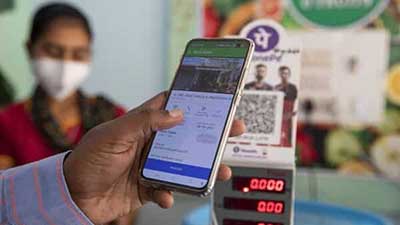Date: 23/03/2023
Relevance: GS-2: Government policies and interventions for development in various sectors and issues arising out of their design and implementation.
Key Phrases: Metapower, G20, Digital Gender Gap, Digital Economy, Digital Revolution, National Family Health Survey, Digital Illiteracy, Cyber Safety, National Digital Library, ‘Stay Safe Online’.
Context:
- India's aim to become a 'metapower' in the digital world seems
achievable with its rapid progress towards being a digitally empowered
nation. But, it is vital to address the digital gender divide for
long-term inclusive growth.
- Bridging this gap will ensure that everyone can benefit from India's digital economy regardless of gender.
Key Highlights:
- According to the National Family Health Survey (2019-21), women
in India have significantly lower rates of internet usage compared to men,
with only one in three women (33%) having ever used the internet in contrast
to over half of men (57%).
- This digital gender gap is more pronounced in rural areas, where men are twice as likely as women to have accessed the internet (49% vs. 25%).
- Despite this disparity, India still boasts the largest number of
women in the world, estimated at 691 million.
- This presents an enormous potential for women to contribute, participate and innovate in the dynamic and ever-expanding digital landscape.
Gendered Barriers:
- The India's digital revolution can gain momentum by addressing
three gender-related barriers:
- Lack of access: Women and girls in rural areas face limited
access to digital devices and services due to inadequate infrastructure,
poor network coverage, and low smartphone penetration. Gender inequality
further exacerbates this problem.
- Increasing smartphone and internet accessibility by expanding connectivity and penetration in rural areas, providing affordable solutions, and educating households on the advantages of digital access can help bridge the access gap.
- Digital illiteracy: The gender digital divide is also
influenced by inequality in functional literacy. Girls with lower
levels of functional literacy struggle to make optimal use of
smartphones.
- The National Family Health Survey (2019-21) found that 59% of women between the ages of 15-49 in urban and rural India have not completed 10 or more years of schooling, in rural India alone at 66%.
- Digital education can help this significant demographic fully engage in the digital world, develop critical and analytical skills, and stay safe online.
- Cyber safety and security: Women and non-privileged genders
with lower levels of digital literacy and skills may be more susceptible
to online harassment, cyberbullying, and cyberstalking.
- These digital risks and harms restrict the ways in which women and girls use digital technologies, which ultimately widens the gender digital divide.
- Addressing cyber safety and security concerns by providing digital literacy and skills training to women and girls can help reduce the digital gender gap.
- Lack of access: Women and girls in rural areas face limited
access to digital devices and services due to inadequate infrastructure,
poor network coverage, and low smartphone penetration. Gender inequality
further exacerbates this problem.
Levelling the Playing Field:
- Although significant progress has been made, immediate action should be
taken in three areas that can have a catalytic impact:
- Designing digital solutions to promote gender equity: Digital
solutions should be developed with consideration for the unique needs of
women and girls.
- Engaging women and girls in co-creation can accelerate digital adoption and reduce the digital gender divide and accessibility gap.
- Digital literacy and capacity building: Empowering young
women and girls with early access to digital technology can help them
engage with it more productively, learn new knowledge and skills, and
increase their confidence in their endeavors.
- Digital literacy is now recognized as essential for employability and has been linked to higher earning potential and new economic opportunities.
- Responsible technology: Protecting user privacy and data must
be a top priority to prevent technology from perpetuating harmful biases
or discrimination against women and girls.
- Collaboration between technology industry stakeholders and the government is necessary to ensure cyber safety and security for users, while encouraging responsible behavior.
- Ensuring a safe and secure digital environment for women and girls is a collective responsibility.
- Designing digital solutions to promote gender equity: Digital
solutions should be developed with consideration for the unique needs of
women and girls.
Government Initiatives:
- Efforts are being made by the government to ensure that women and girls are not left behind in the digital revolution and have access to education, economic opportunities and digital transactions.
- To bridge the digital divide, the government has launched
initiatives such as the Pradhan Mantri Gramin Digital Saksharta Abhiyan
as part of the Digital India vision.
- This initiative aims to provide digital literacy training to rural populations and has already covered 60 million households.
- In the education sector, the National Digital Library for
children and adolescents proposed in the 2023-24 Union budgets.
- It will be instrumental in reducing the digital divide and promoting access to quality education and higher levels of digital literacy.
- Another example of the government's commitment to addressing digital
gender inequality is the "Stay Safe Online" campaign, initiated by
the Ministry of Electronics and IT as part of India's G20 presidency.
- It will increase awareness of the internet, social media and digital payment facilities for the benefit of citizens.
Conclusion:
- The conditions are ripe for a digital revolution that is transformative and gender-equal. India can leverage the positive effects of economic empowerment, social empowerment, and digital empowerment, which are all gaining momentum.
- Providing complete digital access and technology to women and
girls can offer them numerous opportunities to enhance their knowledge,
broaden their perspectives and utilize their potential for personal and
societal growth.
- Bridging the digital divide is crucial to achieve this goal.
Source: Live-Mint
Mains Question:
Q. Discuss the significance of addressing the digital gender divide for achieving inclusive growth in the Indian economy. (150 words).







